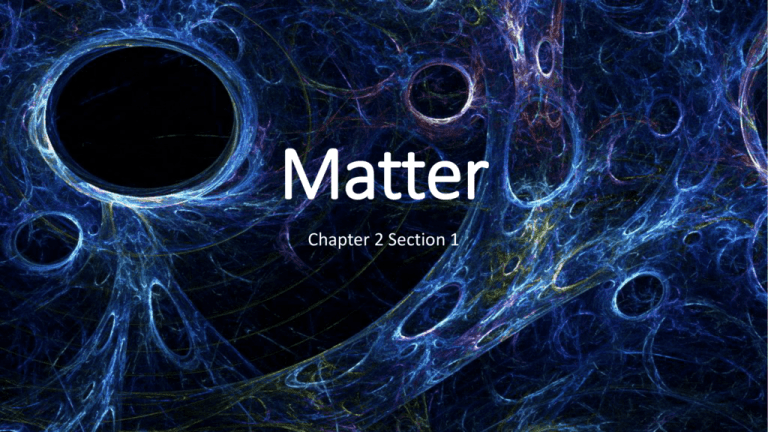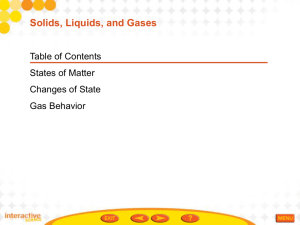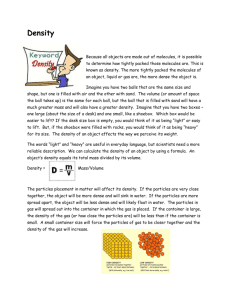Matter
advertisement

Matter Chapter 2 Section 1 Unit Overview In this unit we will cover: • • • • • • States of Matter Changes in Phase The role of Energy Types of Energy Physical Changes Chemical Changes What is Matter? Matter is everything that has volume and has mass. Matter is made up of smaller particles such as atoms, molecules and ions. What is Matter Every particle attracts other particles. The particles themselves are constantly moving. The speed at which the particles move and the strength of the attraction between them determines the material’s state of matter. Physical and Chemical Changes When matter changes it will either undergo a physical change or a chemical change. Physical changes are easily reversed. Chemical changes are not easily reversed. (catalase) States of Matter • Solid • Liquid • Gas • Plasma Solid Particles are packed close together. Does not change shape or take the shape of its container. The particles vibrate in place rather than move out of position. Liquid Takes the shape of its container. The volume of the liquid is always the same regardless of the shape of the container. The particles in a liquid move more freely as they have more energy, but not enough to move far apart. Brownian Motion The movement of molecules in a substance is known as Brownian motion. This is the random motion of particles suspended in a fluid (a liquid or a gas). It results from the collisions between molecules in the fluid. Viscosity Viscosity is ease with which a liquid flows and is determined by the strength of the attraction between particles. The more viscous a liquid the longer it takes to flow. The Pitch Drop Experiment The pitch drop experiment is a long-term experiment that measures the flow of a piece of pitch over many years. Pitch is the name for any of a number of highly viscous liquids that appear solid, most commonly bitumen. At room temperature, tar pitch flows at a very low rate, taking several years to form a single drop. The Pitch Drop Experiment The University of Queensland pitch drop experiment. Professor John Mainstone (taken in 1990, two years after the seventh drop and 10 years before the eighth drop fell). Amorphous Solids Amorphous solids are resistant to changes in shape, like solids, but like liquids, lack a crystalline structure. Surface Tension Surface tension results from the particles pulling towards each other. As no liquid particles are above the liquid the surface tension can be strong enough to balance objects on. The attractions between H2O molecules are known as van der Waal forces. Van der Waal Forces Distributions of partial charges in water – van der Waal forces. These allow water molecules to bind together. This created surface tension and many of the unique properties of water. Gas Most gases are invisible. The air you breath is a mixture of gases. Gas does not have a definite shape or volume. Gas The particles of a gas are much further apart than in a liquid or a solid. There is empty space between the particles. Gas particles move at high speed in all directions. Gas If you poured a small volume of a liquid into a container the liquid would fill the bottom. However if you poured the same volume of gas into a container the gas would fill the container. Gas Decreasing the volume of a container squeezes the gas particles closer together. This increases the pressure. Gas Matter that is generally a liquid or solid at room temperature but exists as a gas is called vapor. For example water vapor is the given name for water when it is in a gas state. What is empty space? Empty space literally has nothing in it. When we say something is empty conversationally we are really being factually incorrect. And empty box is full of gas - air. Plasma If we add enough energy to a gas the molecules can completely break apart. This is known as a plasma. Lightning A plasma is a highly ionized gas containing a roughly equal number of positive ions and electrons. Plasmas conduct electric current. Neon lights are an artificial form of plasms. Lightning is a sudden electrostatic discharge during an electrical storm between electrically charged regions of a cloud. Intra-cloud lightning or IC, or between that cloud and another cloud (CC lightning), or between a cloud and the ground (CG lightning). Thunder and Lightning Which comes first, the thunder of the lightning? LS = 299 792 458 m / s SS = 340.29 m / s The Shape of Matter • Solids have a defined shape • Liquids take the shape of the bottom of a container • Gasses take the shape of an entire container. Freezing and Melting Freezing is the process of moving from liquid state to solid state. Melting is the process of moving from solid state to liquid state. When we add more energy into a substance the particles have more energy and move around more. This is what we see happening when ice melts. Freezing and Melting Freezing Melting Vaporization and Condensation Vaporization is the process of moving from liquid into gas form. Condensation is the process of moving from gas into liquid form. As a gaseous substance loses energy the particles slow down and they can begin to form liquids. Vaporization and Condensation Vaporization Condensation Ionization and Deionization When a gas is super heated it may start to break apart. At this point it undergoes ionization and becomes a plasma. In a plasma H ions, and electrons break off. Since they have a positive or negative charge a plasma is a highly ionized gas that has roughly an equal charge. Ionization and Deionization Ionization => <= Deionization Deposition and Sublimation When a substance moves straight from being a gas to being a solid this is deposition. When a substance moves straight from being a solid to being a gas this is sublimation. Deposition and Sublimation Sublimation e.g. Solid => Gas Under normal circumstances how will this solid change phase into a gas? Sublimation Melting






